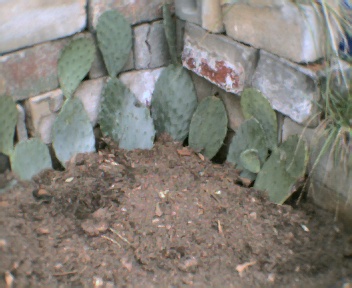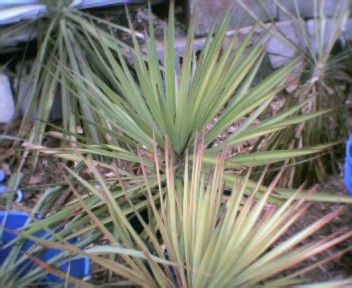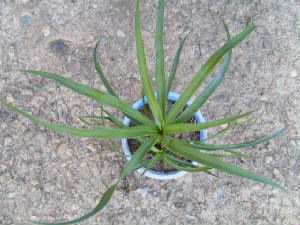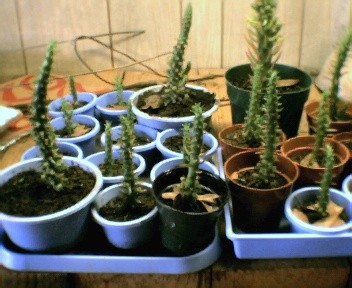| Elder plants produce huge leaves |

|
| These are up to 16 inches. |
1 gigantic(13 inches minimum)prickly pear leaf
pre-rooted plants $15 shipping included!!
A fantastic buy. Check M.O., and Paypal accepted.
average sized leaves pre-rooted $11
| Nice corner filler |
|
|
| Thrives potted |
Ground cactus. Blooms in spring. Excellent indoors or out doors.
$3
YUCCA

1 ADAMS NEEDLE YUCCA-$4
5 ADAMS NEEDLE YUCCA-$12.75
10 ADAMS NEEDLE YUCCA-$21
| Adams Needle Yucca |

|
| Seedlings that have grown since early spring |
The flat-jointed paddles of the prickly pear are not leaves, but an adaptation of a stem from which the fruit grows. The cactus
paddles, "Nopales," are also a commonly used ingredient in Mexican recipes, including salads and scrambled eggs.
The prickly pear fruit normally ripens and is ready for harvest during the late summer and early fall months. When gathering
the fruit, wear leather or rubber gloves to avoid contact with the cactus needles. They are a nuisance, especially the tiny
soft-appearing barbs of glochids on the fruit itself. The glochids are very difficult to remove if you get them in your skin.
A long-handled tong can also be used to pick the fruit from the cactus. Once you have harvested the fruit, you will need to
remove the glochids by passing the fruit through an open flame or shaking the fruit in a bag of hot coals. The glochids can
also be removed by cutting them away with a knife or peeling off the skin. Once the fruit is removed from the cactus, it will
rapidly lose nutritional value and may ferment, so try to consume or process soon after harvesting. After you have removed
the glochids you can eat the fruit fresh, or prepare it in several ways. Prickly pear juice can be used to make jelly, conserve,
marmalade or poured on salads. It can also be mixed with other juices to make smoothies, shakes and other refreshing beverages.
Mixing the juice with 7-Up or ginger ale will give you a tasty drink similar to a Shirley Temple.
Hey Randall,
My yucca and cactus are growing like crazy!
The big yucca is slowly catching up and starting new growth but
the small one just took off and started sprouting within a few weeks, doubled in size or more like tripled.
1 cactus stayed
in tact and has 4 new big segments and starting a few more.
The other cactus I broke in 3 peices and planted them
seperatly, now they all have new sprouts. 1 has 3 new sprouts. Pics soon as I finish landscaping around them.
~ Bill ~
| Other cacti available |

|
| Click here to see more |
Desert USA

Welcome to our web site!
The flat-jointed paddles of the prickly pear are not leaves, but an adaptation of a stem from which the fruit grows. The
cactus paddles, "Nopales," are also a commonly used ingredient in Mexican recipes, including salads and scrambled
eggs.
|
|
Prickly Pear Cactus have been a staple food of Native Americans for many centuries. Their large, colorful blossoms appear
in yellow, pink, red or purple and grow from the tip of cactus nodules, which later ripen into delicious red fruit. Many varieties
of prickly pear cactus grow wild throughout the deserts of the Southwest, but many are not native.
Some species of prickly pear cactus were introduced into North America from tropical America a number of centuries ago.
The fruit of these cultivated prickly pear cactus is a common delicacy in Mexico and is sold in markets as "tuna."
While all prickly pear cactus are of the genus Opuntia, the non-native Opuntia megacantha is one of the tastiest and most
popular. Some native species, especially those with
dark purple fruit, are not as flavorful.
The plants are the large outdoor variety, and are excellent for landscaping. They bloom in the spring with large yellow flowers.
When the blooms die they form large purple pods that are quite attractive as well!
These cacti can survive freezing and grow 12 inches and more each year, forming new leaves and growing to 4 and 5 feet
in height.
| THIS IS AN EXAMPLE OF WHAT |

|
| A 10 PAD ORDER IS SENT AS |
|
